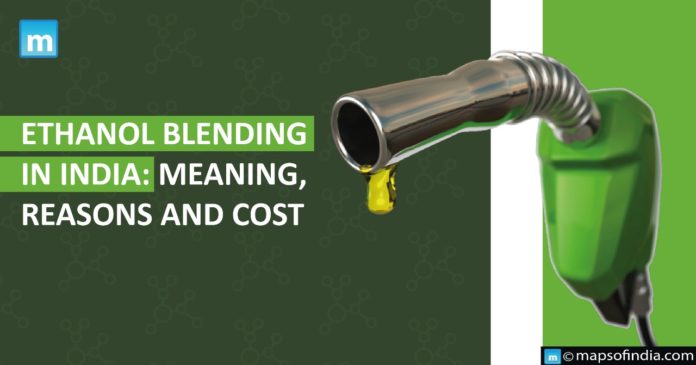On the occasion of “World Environment Day,” Prime Minister Narendra Modi announced that India ranked 3rd in the automobile sector. He also declared that India had achieved a 10% target of “ethanol blending” before time.
According to a report from the press information bureau (PIB), India adopted ethanol blending to enhance India’s energy security, reduce dependency on fuel imported by middle-east countries and raise the agricultural sector. The government has implemented an Ethanol Blending Petrol (EBP) programme in the nation, excluding the Union Territories of Andaman, Nicobar, and Lakshadweep islands.
What is Ethanol?
Ethanol is an organic compound obtained from biomass and is a combination of ethyl and alcohol. It has a higher octane number than gasoline, improving the octane number of petrol. Ethanol is obtained primarily from sugarcane. Many alcoholic beverages consist of ethanol.
Why was Ethanol blending introduced?
The concept of Ethanol blending was introduced in India as an alternative to costly fuels such as petrol and diesel. There are many other reasons why ethanol blending was introduced in India.
The reasons are as follows:
1. Less pollution
Blending ethanol with petrol reduces carbon emissions. Ethanol contains oxygen, which helps in the complete combustion of fuel. Ethanol is environmentally friendly and does not harm the environment compared to petrol and diesel.
Ethanol is a renewable fuel which is domestically produced in the nation itself. E10, A low-level blend of ethanol. It is a composition of 10% ethanol and 90% gasoline. E10 helps the most in reducing emissions of harmful gases. Recently, in 2021 and 2022, ethanol reduced 27 lakh tonnes of carbon emissions.
2. Reduction in import dependency
India is the third-largest consumer of crude oil in the world. It imports most of the fuel from middle-eastern countries, like Iraq, Saudi Arabia, and the United Arab Emirates. In 2020–2021, India imported 212.2 million tonnes of oil.
E85, a mixture of 85% ethanol in fuel, is cheaper than a gallon of gasoline. Due to the ethanol blending, India saved Rs 41,000 crore.
3. Waste management
The main sources for obtaining Ethanol are the wastes of wheat, sugarcane, rice, and other grains. Farmers set fire to the waste of grains, which causes air pollution. Instead of disposing of the waste, industries like Hindustan Petroleum, Bharat Petroleum, and Indian oil convert the waste to Ethanol.
The process of blending Ethyl alcohol with petrol includes fermentation, which manages waste such as sugarcane, broken rice, maize, and stubble.
4. Boost to agriculture :
Ethanol achieved its target of 10%. To meet the requirement, more crops are required. Farmers use different patches of land to grow crops, which help blend ethanol. The cultivation of crops with the purpose of blending has boosted agriculture.
Indian government’s steps towards it
- Reduction in Good and Service Tax (GST) from the crops and waste that contribute to the blending. Under the ethanol blending programme, the tax was reduced from 18% to 5%.
- The government has opened an alternate path for ethanol production and transportation of blended ethanol to the oil stations.
- The Indian government has amended the “Industries (Development and Regulation) Act of 1951 for the nation’s smooth production and transportation of ethanol.
- Ethanol produced by different ingredients costs different. There will be different price ranges and options.
How much does ethanol cost?
A litre of Ethanol currently costs Rs. 61. The cost of ethanol depends on the internal fuel prices. Its price varies in different parts of the country. However, ethanol is way cheaper than petrol. The cost of petrol is double that of ethanol.




